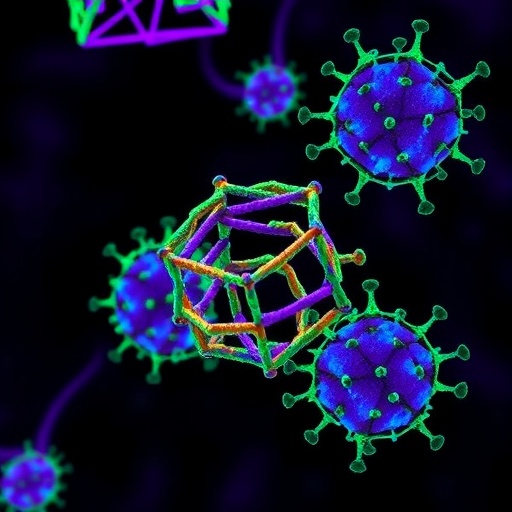Recent advances in cancer immunotherapy and chemotherapeutic research have increasingly focused on understanding the molecular mechanisms behind immunogenic cell death (ICD) triggered by anticancer agents. An illuminating new study by Zhang, L., Liu, Y., Yang, H., and colleagues, published in Cell Death Discovery in 2025, sheds unprecedented light on the role of OASL (2’-5’-oligoadenylate synthetase-like protein) in modulating oxaliplatin-induced immunogenic cell death in gastric cancer. This research unveils how the cGAS-STING signaling pathway is intricately involved in this process, paving the way for novel therapeutic interventions that potentiate the immune system’s ability to target gastric tumors.
Oxaliplatin, a platinum-based chemotherapeutic agent, has been a frontline treatment for gastric cancer due to its efficacy in inducing tumor cell death. However, recent clinical observations have suggested that its anticancer efficacy transcends mere cytotoxicity. Instead, oxaliplatin uniquely triggers immunogenic cell death—a form of apoptosis that not only kills tumor cells but also primes the immune system to recognize and attack residual cancer cells. Nonetheless, the molecular conduits that enhance or modulate this ICD remain incompletely characterized. The discovery of OASL’s regulatory function in this context constitutes a breakthrough in understanding the immunomodulatory landscape influenced by chemotherapy.
The cGAS-STING pathway, a crucial conduit of cytosolic DNA sensing, is a pivotal lipid signaling axis that alerts the immune system to the presence of foreign or aberrant DNA within cells. Cyclic GMP-AMP synthase (cGAS) detects cytosolic DNA fragments, synthesizing cyclic GMP-AMP (cGAMP) as a secondary messenger. This molecule subsequently activates STING (Stimulator of Interferon Genes), triggering a cascade of type I interferon production and driving potent innate and adaptive immune responses. Zhang and colleagues reveal that oxaliplatin’s ICD-inducing effect is profoundly linked to the activation of this DNA sensing machinery.
At the cellular level, OASL emerges as a key modulator that finely tunes the cGAS-STING pathway’s responsiveness to oxaliplatin-induced stress. Previously recognized predominantly for its antiviral roles, OASL’s engagement in cancer immunology represents a paradigm shift. The authors demonstrate that OASL upregulation enhances the accumulation and recognition of DNA fragments released during oxaliplatin treatment, thus amplifying cGAS-mediated cGAMP production. This augmented signaling leads to a magnified interferon response, heightening tumor immunogenicity and promoting the recruitment of immune effector cells to the tumor microenvironment.
Methodologically, the study employs an extensive array of in vitro and in vivo investigations, utilizing gastric cancer cell lines, murine tumor models, and comprehensive immunological assays. Through genetic manipulation techniques, including CRISPR-Cas9-mediated knockout and RNA interference of OASL, the researchers delineate its indispensable role in dictating oxaliplatin’s immunogenic potential. Moreover, the deployment of reporter assays measuring interferon-stimulated gene expression provides quantitative insights into how OASL levels dictate immune activation magnitude.
Intriguingly, the findings suggest that OASL deficiency or downregulation severely blunts the effectiveness of oxaliplatin treatment. Tumors lacking adequate OASL expression fail to mount adequate cGAS-STING responses, leading to mitigated type I interferon production and diminished dendritic cell activation. This results in a subdued adaptive immune response with fewer cytotoxic T lymphocytes infiltrating the tumor niche. Consequently, resistance to oxaliplatin emerges partially through immune evasion mechanisms mediated by altered OASL-cGAS-STING signaling dynamics.
The clinical implications of this research are profound. Gastric cancer patients exhibiting lower OASL expression profiles in their tumor cells might benefit from tailored treatments that combine oxaliplatin with agents designed to restore or mimic OASL function. Furthermore, pharmacological activators of the cGAS-STING axis could be synergistically employed to boost chemotherapy-induced immunogenicity, thereby transforming immunologically “cold” tumors into “hot” ones susceptible to immune attack. These strategic approaches could revolutionize personalized medicine paradigms in gastric oncology.
What sets this study apart is its meticulous dissection of the molecular interplay connecting chemotherapy, innate immune sensing, and adaptive immune priming. While earlier work acknowledged that oxaliplatin could induce ICD, Zhang and colleagues provide a mechanistic narrative by integrating OASL into this framework. They portray OASL as a molecular rheostat, calibrating the immune system’s emergency alarms in response to chemotherapy-induced cellular distress. Such mechanistic insights hold promise to inform the development of next-generation combinatorial therapies.
Beyond gastric cancer, the research opens intriguing avenues for broader oncologic applications. Given that the cGAS-STING pathway plays a fundamental role in immune surveillance across diverse tumor types, the modulation of OASL may similarly enhance the immunogenic potential of chemotherapy in other malignancies. Future studies will undoubtedly explore this prospect, potentially extending these novel findings to colorectal, lung, and pancreatic cancers where oxaliplatin and related agents are also clinically relevant.
This research carries significant translational potential. The biomarkers identified—particularly OASL expression levels—could serve as predictive indicators of patient responsiveness to oxaliplatin-based regimens. Clinicians might utilize these biomarkers to stratify patients best suited for immunogenic chemotherapy combinations, optimizing therapeutic outcomes while minimizing unnecessary toxicity. Additionally, the elucidation of cGAS-STING pathway intermediates offers targets for drug discovery aimed at potentiating immune-mediated tumor clearance.
Critically, the study also addresses a growing challenge in oncology: overcoming tumor immune evasion. By pinpointing the mechanistic bottlenecks through which tumors evade immune detection after chemotherapy, Zhang et al.’s work provides a blueprint for reversing immunosuppression at the tumor site. Amplifying OASL activity or cGAS-STING signaling may enhance not only chemotherapy but also act as an adjuvant for immune checkpoint inhibitors, which have revolutionized cancer treatment but remain ineffective against many gastric tumors.
The authors further discuss potential safety considerations. Given that hyperactivation of type I interferon pathways can sometimes provoke deleterious inflammatory effects, the regulation of OASL and cGAS-STING activation must be finely balanced. Future therapeutic designs will need to carefully calibrate this immune activation to maximize anticancer efficacy while avoiding excessive autoimmunity or systemic inflammation. The study’s detailed molecular findings provide essential knowledge to inform such therapeutic fine-tuning.
In summary, this compelling investigation underscores the powerful synergy between chemotherapeutic agents and innate immune sensors orchestrated by OASL. The cGAS-STING signaling pathway emerges as a central conduit by which chemotherapy-induced DNA damage communicates with the immune system, ultimately dictating treatment success. These insights herald a new era in cancer immunotherapy research where molecular tailoring of intrinsic immune pathways can transform standard chemotherapy into potent immunogenic weaponry against tumors.
As oncologists and immunologists seek increasingly sophisticated strategies to harness the patient’s immune system against cancer, understanding molecular regulators like OASL represents a critical leap forward. This work not only deepens fundamental biological knowledge but also offers an actionable framework to enhance clinical cancer care. Future research inspired by this landmark study will no doubt accelerate the translation of molecular immunology into lifesaving treatments, offering renewed hope to patients battling gastric cancer and beyond.
Subject of Research:
The molecular mechanisms by which OASL influences oxaliplatin-induced immunogenic cell death in gastric cancer through the cGAS-STING signaling pathway.
Article Title:
Effect of OASL on oxaliplatin-induced immunogenic cell death in gastric cancer via the cGAS-STING signaling pathway.
Article References:
Zhang, L., Liu, Y., Yang, H. et al. Effect of OASL on oxaliplatin-induced immunogenic cell death in gastric cancer via the cGAS-STING signaling pathway. Cell Death Discov. (2025). https://doi.org/10.1038/s41420-025-02850-w
Image Credits: AI Generated
DOI: https://doi.org/10.1038/s41420-025-02850-w
Tags: breakthroughs in cancer immunotherapy researchcGAS-STING signaling pathwaychemotherapy and immune system interactionenhancing immune response to cancerimmunogenic cell death in gastric cancerimmunomodulation by anticancer agentsmolecular mechanisms of cancer treatmentnovel therapeutic interventions for gastric tumorsOASL role in cancer immunotherapyoxaliplatin mechanism of actionplatinum-based chemotherapy researchtumor cell apoptosis and immune recognition





